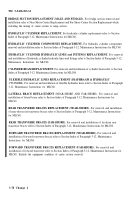TM-5-5420-203-14 - Page 253 of 298
TM 5-5420-203-14
CHAPTER 5
ADMINISTRATIVE STORAGE OR SHIPMENT
5-1. ADMINISTRATIVE STORAGE.
Administration storage is accomplished in one of two modes;
long term or standby.
Long Term Mode
. Bridge long term storage (War Reserves) is usually depot storage in an area out of the
elements and includes periodic checks to determine equipment condition.
Standby Mode.
Bridge standby storage maintains the bridge in an “immediately available” condition. This mode
can be accomplished with the bridge launcher-mounted or the bridge without the launcher.
Standby Mode-Bridge Launcher- Mounted.
Perform vehicle PMCS (TM 5-5420-202-20 or TM 5-5420-
226-20). Perform
bridge
PMCS (page 2-3) . Perform bridge lubrication instructions (page 3-1). Coat all surfaces
of pins, cables, etc., with a light film of petroleum to retard corrosion. Ensure all pins, pin retainers, etc., necessary
for the operation of the bridge are maintained with the bridge or stored in an appropriate place.
Exercise
the bridge
a minimum of one time each month (TM 5-5420-202-10 or TM 5-5420-226-10).
Exercise consists of a series of three
launchings and retrievals. After the last retrieval, check the connecting points, hydraulic hoses, and connectors for
leaks or damage. Report any discrepancies found on DA Form 2404, Equipment Inspection and Maintenance
Worksheet. Fill in all necessary blanks and explain the problem fully.
Standby Mode-Bridge Without Launcher
. Perform bridge PMCS (page 2-3) . Perform bridge
lubrication instructions (page 3-1). Coat all surfaces of pins, cables, etc., with a light film of petroleum to retard
corrosion. Ensure all pins, pin retainers, etc., necessary for the operation of the bridge are maintained with the
bridge or stored in an appropriate place. Bridge standby storage can be in either the launched position or in the
clamshell position.
a. Launched Position
.
Store the bridge laying flat on a firm surface such as the Unit’s compound
or a concrete surface. If storing the bridge on concrete, place two light wood blocks under the bottom center
hinge points in the middle of the bridge (figure 5-1, view A). This will reduce the wear on these two critical areas.
If the bridge is to be stored for a period in excess of 30 days, place wood blocking supports under the hydraulic
cylinder (figure 5-1, view B) to distribute the weight
placed on the hydraulic seal by the extended cylinder arm.
.
Periodic checks of the bridge and the hardware shall be performed to ensure no items have been removed.
b. Clamshell Position.
Before positioning the bridge, raise the bridge to a near vertical position and
secure the tie rods together with a 3/8-inch chain or wire rope (figure 5-2, view A).
.
Store the bridge on a firm surface
such as hard sand or earth. Position the bridge in the storage area with wooden blocks supporting the rear of the
bridge
(figure 5-2, view B).
This will permit the launcher to engage or disengage the bridge without damaging the
tie rods. Do not remove
the tie rod chains during storage period.
The bridge can stay in a standby mode almost indefinitely. The bridge and its hydraulics shall be
exercised a minimum of once each month. This exercise shall consist of a series of three retrievals and launchings.
At the completion of the second launch and prior to the final extension of the bridge, inspect the bridge for obvious
faults as addressed in PMCS. Report any discrepancies found on DA Form 2404, Equipment Inspection and
Maintenance Worksheet. Fill in all necessary blanks and explain the problem fully. After the repairs, if any, are
completed, the bridge is once again in a standby mode.
5-2. SHIPMENT.
For information on how to transport the bridge, refer to Chapter 2.
Change 3
5-1
Back to Top




















